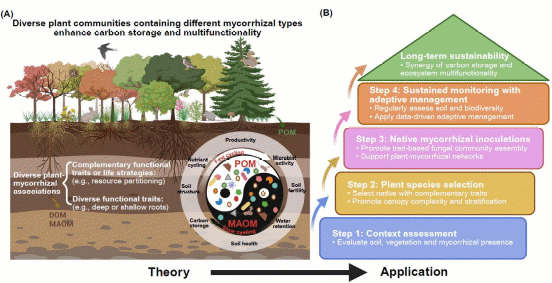Unveils "Plant-Mycorrhiza Synergy" Framework to Revolutionize Forest Restoration
Groundbreaking approach solves carbon-biodiversity trade-off in degraded forests
Confronting the dual crises of global forest degradation and climate change, traditional forest restoration strategies focused solely on aboveground carbon storage face significant limitations, including slow soil carbon recovery and inadequate ecosystem functionality.A pioneering international study led by the South China Botanical Garden (SCBG), Chinese Academy of Sciences (CAS), published in the prestigious journal Trends in Ecology & Evolution, introduces a transformative "Plant-Mycorrhiza Synergy" framework. Developed with partners from Germany, the USA, Czech Republic, the Netherlands, and Italy, this science-based solution synergizes carbon sequestration with biodiversity recovery.
Underground Alliance: AM and ECM Fungi Drive Dual Benefits
Synthesizing global forest biodiversity data, researchers identified complementary roles of the two dominant mycorrhizal fungi types:
Arbuscular Mycorrhizal (AM) Fungi: Partnering plants act as "deep carbon engineers." Their high-quality litter, root exudates, and extensive fungal networks drive the formation and stabilization of Mineral-Associated Organic Matter (MAOM) in deep soil layers, enabling long-term carbon storage, water retention, and fertility.
Ectomycorrhizal (ECM) Fungi: Partnering plants serve as "surface-active stewards," producing slow-decaying litter and competing for nitrogen. This boosts Particulate Organic Matter (POM) accumulation in topsoil, vital for soil structure, nutrient supply, microbial activity, and short-term productivity.
In diverse mixed forests, AM and ECM fungi synergize: deep MAOM ensures long-term carbon stability, while surface POM supports ecosystem vitality. This dual action significantly increases total carbon storage while concurrently enhancing nutrient retention, drought resilience, disturbance resistance, and biodiversity – achieving true "carbon-multifunctionality" synergy.
A Practical Four-Step Blueprint for Global Forest Restoration
The team translates theory into an actionable "Assess-Select-Inoculate-Monitor" framework:
1. Baseline Assessment: Prioritize local conditions (climate, soil, vegetation, dominant mycorrhizal type – e.g., AM-dominant tropics vs. AM/ECM mixes in temperate/boreal zones).
2. Strategic Species Selection: Combine deep/shallow-rooted, fast/slow-growing trees, and AM/ECM-associated species to optimize resource use and carbon distribution.
3. Targeted Mycorrhizal Inoculation: Rebuild soil microbiomes using native, high-efficiency fungal strains to boost plant establishment and stress tolerance.
4. Adaptive Monitoring: Track key indicators (e.g., POM/MAOM ratios, biodiversity) to dynamically refine management.
Global Impact and Future Vision
"This framework harnesses 450 million years of natural wisdom, transforming plant-mycorrhizal symbiosis into a quantifiable restoration tool," stated corresponding author Dr. LIU Zhanfeng (SCBG, CAS). Validation comes from SCBG’s 60-year tropical coastal restoration project: mixed forests showed ~40% higher soil carbon storage and significantly recovered biodiversity compared to monocultures. This science offers a vital "belowground solution" for the UN’s Kunming-Montreal Global Biodiversity Framework, shifting restoration paradigms from merely "planting trees" to intelligently "engineering ecosystem function." Future steps include integrating mycorrhizal traits into global restoration metrics and expanding validation via networks like TreeDivNet and Sino-BEFNet.Paper Link: https://doi.org/10.1016/j.tree.2025.07.004

Figure. Conceptual framework for synergistic soil carbon and ecosystem restoration via plant-mycorrhizal integration.(Imaged by LI et al)
File Download: